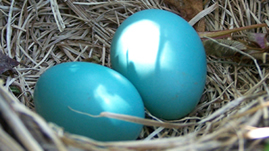Teachers' Domain - Digital Media for the Classroom and Professional Development
User: Preview


KET's Everyday Science is funded in part by Kentucky Power and the American Electric Power Foundation and PNC Bank.
Weather is something we experience everyday. It’s a great learning tool for young children because it leads to exploration and discovery. For young children, studying the weather is based on experiencing the outdoors and understanding the changes that come with each season.
This resource is part of the KET Everyday Science collection.
The earth changes with each season—and your class will enjoy and learn from these changes. Children notice these daily and seasonal changes by the way they affect us. By helping children observe and record their observations, we help them begin to understand the concept of cycles.
In spring, we notice the trees start to get leaves, and birds come back from the places they spend the winter. In fall, the leaves on the deciduous trees change color, and eventually fall off as the trees get ready for a long winter's nap. Then, in spring, the cycle begins again. Just like the trees and the birds, people also make changes with the seasons. As the seasons change, we wear different clothes, depending on the weather. We play different games in warmer months as opposed to the games we play when it is colder outside. We celebrate different holidays that are unique to a particular season.
For this module, you could try to create an ongoing learning environment instead of a one-time activity. Start the day by encouraging the children to watch the morning weather forecast and determine how that forecast will impact their day (whether they will be able to go outside to play, will they need a jacket, etc.).
The Summer and Winter Solstice, and the Spring and Fall Equinox, occur on different dates each year. Refer to your individual calendars for these exact dates.
Vocabularyspring, summer, fall, winter, weather, sun, wind, rain, snow, thermometer, forecast
1. Introduce each season by creating a large calendar for each month of that season. Include the name of the season (as well as the names of the months) and small graphics for holidays.
2. Encourage the children to take turns marking off the days of the week on the calendar each morning.
3. Encourage discussion based on the following questions about the weather conditions of the day and that relationship to the current season:
4. Take a nature walk (weather permitting) to give the children an opportunity to see the changes the season brings. Record their findings on a chart.
5. Document holidays taking place during the season. Some holidays will provide opportunity to study customs around the world and integrate social studies and geography into the science curriculum.
 Loading Standards
Loading Standards Teachers' Domain is proud to be a Pathways portal to the National Science Digital Library.
Teachers' Domain is proud to be a Pathways portal to the National Science Digital Library.
